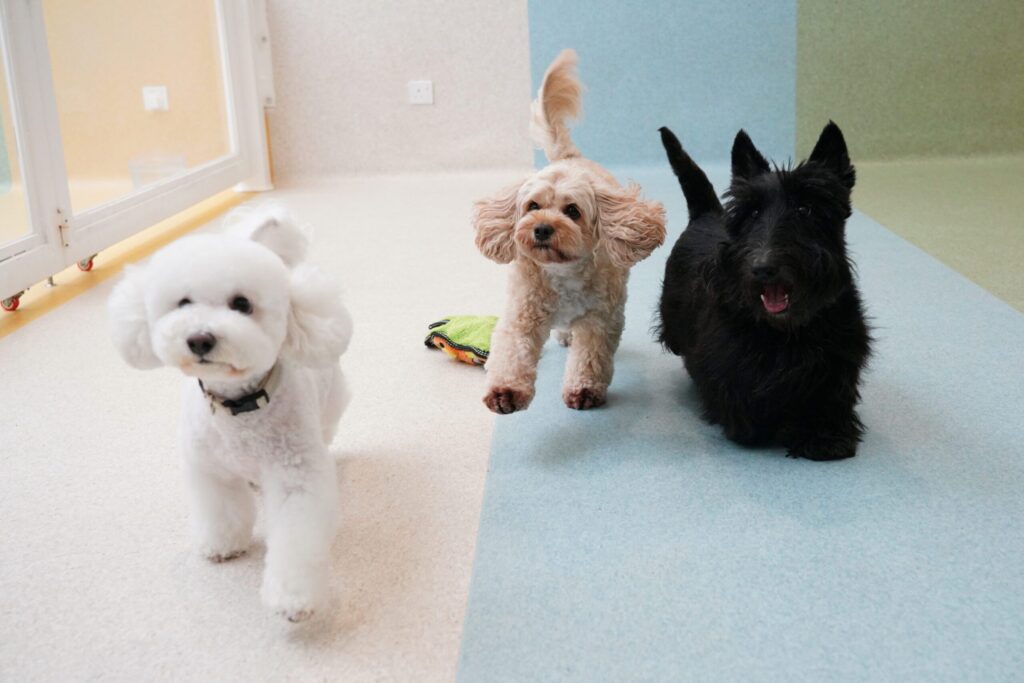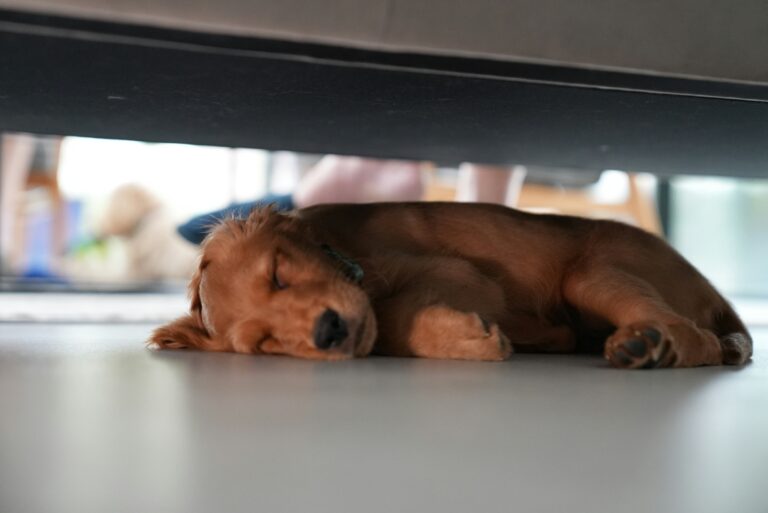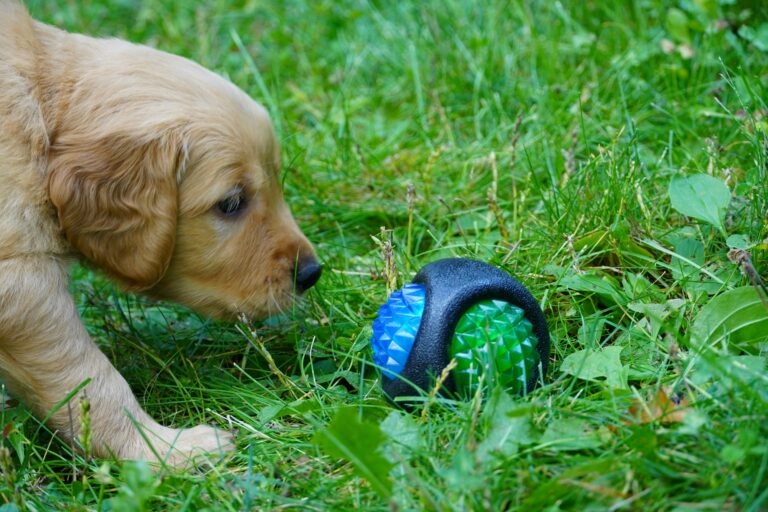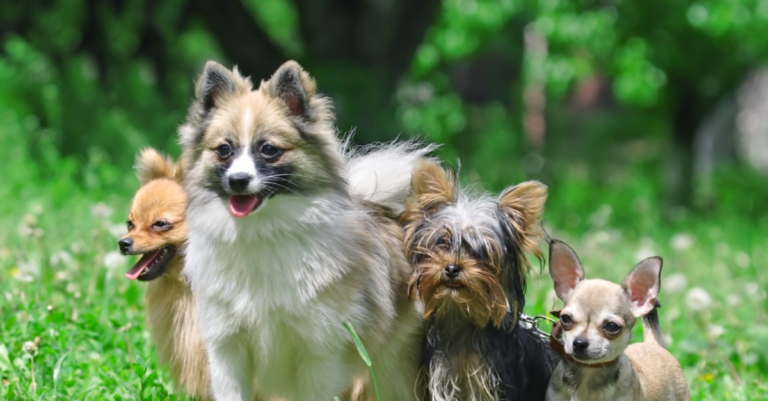Jumping for joy may seem adorable when it comes to small dogs, but it could potentially lead to unwanted scenarios and even injuries. To address this issue, the focus of this upcoming content is how to teach your small dog proper greeting etiquette and prevent unwanted leaps.🐾
In the world of canines, size doesn’t matter when it comes to expressing excitement. Even the tiniest pups can turn into little springs of joy, leaping around and even jumping on guests. While this may initially be cute, it can become problematic, especially if guests aren’t as dog-friendly or if they are frail or young children. Learning to keep four paws on the ground is a valuable lesson for all dogs, regardless of size.🐕
This content is designed to provide comprehensive guidelines on how to teach your small dog appropriate manners when greeting people. It offers practical, step-by-step advice to ensure the learning process is both effective and enjoyable for you and your furry friend. From setting up initial boundaries to positive reinforcement techniques, we’ll be covering it all.🦴
In addition, we will also explore some common reasons why dogs jump up in the first place. Understanding the root of this behavior is crucial for implementing successful training strategies. Along with expert advice, we will also provide real-life examples and experiences to further enhance your understanding of this common canine issue.🐶
With the help of this upcoming content, you will be well-equipped to transform your small dog’s exuberant leaps into a polite greeting behavior. Say goodbye to those frantic and uncontrolled jumps, and look forward to calm and respectful greetings from your small dog. Get ready to jump into a more harmonious relationship with your pet!🎉

Understanding the Behavior of Small Dogs
The behavior of small dogs often reflects their instinctive nature and their environment. These dogs may leap and jump to express their excitement and affection. This behavior, while endearing to some, can become problematic when not appropriately controlled, especially during greetings. Understanding why dogs jump can be the first step towards rectifying this behavior.
Small dogs, in particular, might feel the need to jump to compensate for their size. They leap to get closer to our faces and to draw attention. It is also a way for them to communicate and interact with their environment, using their physical bodies when they cannot use words. Many small dogs experience a strong drive to seek proximity and social contact, especially with their trusted human companions. Their small stature can make them feel vulnerable, and jumping provides a mechanism to bridge the physical gap between them and the people they trust and love.
Establishing a Training Routine
Training a dog to curb its natural instincts requires a structured and consistent routine. It is important to keep in mind that every dog is unique, and what works for one may not work for another. However, there are general methods that can be adopted to teach your small dog proper greeting etiquette.
Training should begin in a controlled environment free from excessive distractions. Starting at home where the dog feels safe allows for gradual learning. Once basic behaviors are established, you can introduce more challenging scenarios, such as greetings at the door or during walks.
Routine is critical because dogs thrive on predictability. Scheduling training sessions at the same time each day reinforces the concept of consistency, helping the dog understand expectations more clearly. Each session should be kept short but frequent to maintain the dog’s attention and prevent frustration.
Reinforcing Positive Behaviors
Positive reinforcement is a well-regarded method of teaching dogs to behave appropriately. The process involves rewarding the dog when it exhibits desired behaviors. Rewards can range from treats and verbal praise to petting or playtime. Identifying what motivates your dog is key to choosing the most effective reward.
Ignoring Unwanted Behaviors: When your dog jumps, do not give it any attention. This includes avoiding eye contact and physical touch. When the dog stops jumping, give it attention. This teaches the dog that calm behavior is what earns them your interaction.
Providing Rewards: Reward your dog immediately when it displays appropriate behavior. Timing is crucial, as delayed rewards can confuse the dog about which behavior is being reinforced. Consistent, immediate rewards strengthen the desired behavior and make it more likely that the dog will repeat it in the future.
Consistency is Key
It is essential to be consistent with the training regimen. All family members and visitors should be aware of the rules and expectations. If one person allows the dog to jump, it will confuse the dog and slow down the training process.
Clear communication among everyone interacting with the dog ensures that training methods are uniform. This includes using the same commands, body language, and reward systems. Consistency provides clarity for the dog and increases the chances of success.
Consistency should also extend to the dog’s environment. Keeping familiar routines for feeding, walking, and playtime contributes to a sense of security and reduces the likelihood of anxiety-driven behaviors like jumping.
Teaching Commands and Tricks
Commands and tricks can be useful tools to redirect the dog’s energy and attention from jumping. Dogs have a natural ability to learn and perform tricks, which can be used to our advantage when training them.
Commands Like “Sit” and “Stay”
Teaching your dog the command “sit” can be a powerful tool. When the dog is about to jump, command it to “sit.” This will teach the dog that it is more rewarding to sit and greet than to jump. Consistent practice of the “sit” command in various environments and scenarios helps the dog generalize the behavior beyond just training sessions.
Similarly, the “stay” command can be beneficial. Train your dog to stay when guests arrive until it is calm enough to greet them properly. Reinforcing the stay command with high-value rewards during guest arrivals strengthens the behavior and prevents unwanted excitement.
Tricks as a Form of Distraction
Training your dog to perform tricks can be a fun and engaging way to distract them from jumping. Tricks like “shake hands” or “roll over” can engage the dog’s attention and prevent it from jumping in excitement.
Advanced tricks such as spinning in a circle, playing dead, or fetching a toy can serve as both physical and mental stimulation. By channeling the dog’s energy into performing tasks, you are providing an alternative outlet for their enthusiasm.
Addressing Underlying Issues
Sometimes, frequent jumping can be a sign of underlying issues. It is essential to address these issues to ensure the well-being of your pet.
Separation Anxiety
Dogs with separation anxiety might jump excessively as a sign of their stress. If you suspect that your dog suffers from separation anxiety, consult with a professional. They can help with training methods and potentially recommend medication.
Lack of Exercise
Small dogs have a lot of energy. Lack of exercise can cause them to vent their pent-up energy by jumping. Regular exercise and playtime can help reduce their urge to jump. Daily walks, structured play sessions, and even agility exercises tailored for small breeds can significantly help manage their energy levels.
Mental Stimulation
In addition to physical exercise, dogs need mental challenges to stay balanced. Puzzle toys, scent games, obedience exercises, and interactive play sessions are excellent ways to keep a dog mentally satisfied. Boredom can lead to an increase in undesirable behaviors like jumping.
Health Concerns
Certain health concerns can cause excessive jumping or hyperactive behavior. If you notice any unusual behavior or signs of distress, consult a vet immediately. It is always better to be safe than sorry when it comes to your pet’s health.
Pain or discomfort may cause a dog to seek more attention through jumping. Regular veterinary checkups ensure that your dog is in good health and not acting out due to unseen medical issues.
Creating a Controlled Greeting Environment
Setting up a controlled environment when guests arrive can significantly assist in managing a small dog’s greeting behavior. Using baby gates, crates, or leashes allows you to control the dog’s access until it has calmed down.
Guests should be instructed not to engage with the dog until it is sitting calmly. This teaches the dog that calm behavior results in attention and affection, reinforcing polite greeting manners.
Pre-arranged greeting scenarios with familiar friends can be great practice for the dog. Rehearsing controlled greetings helps the dog learn that excitement and jumping do not result in rewards.
Utilizing Professional Training Resources
Sometimes professional help is necessary, especially if initial efforts do not yield significant results. Professional trainers specializing in positive reinforcement methods can provide tailored advice and training plans.
Group obedience classes also offer socialization opportunities and structured learning environments. Small dogs can benefit greatly from the controlled exposure to new people, dogs, and situations that group classes provide.
Behavior consultants can work one-on-one with owners to assess the dog’s environment, lifestyle, and behavior patterns. This allows for a deeper understanding of the root causes of jumping and the creation of highly individualized solutions.
Encouraging Calmness Through Daily Interactions
Encouraging a calm demeanor should extend beyond greeting scenarios. Everyday interactions with your dog should reinforce calmness. Avoid getting the dog overly excited during play or when returning home after absences.
Greeting your dog only after it has calmed down, and not immediately upon entering the house, teaches patience and reduces overall arousal levels. Calmness becomes the new normal and jumping gradually diminishes as an outlet for excitement.
Practicing impulse control exercises, such as having the dog wait before eating or going outside, helps develop self-control that translates into more polite greeting behaviors.
Reinforcing Positive Behaviors
Positive reinforcement is a well-regarded method of teaching dogs to behave appropriately. The process involves rewarding the dog when it exhibits desired behaviors.
- Ignoring Unwanted Behaviors: When your dog jumps, do not give it any attention. This includes avoiding eye contact and physical touch. When the dog stops jumping, give it attention.
- Providing Rewards: Reward your dog immediately when it displays appropriate behavior. This could be a treat, praise, or petting. The reward will encourage the dog to repeat the behavior.
Consistency is Key
It’s essential to be consistent with the training regimen. All family members and visitors should be aware of the rules and expectations. If one person allows the dog to jump, it will confuse the dog and slow down the training process.
Teaching Commands and Tricks
Commands and tricks can be useful tools to redirect the dog’s energy and attention from jumping. Dogs have a natural ability to learn and perform tricks, which can be used to our advantage when training them.
Commands Like “Sit” and “Stay”
Teaching your dog the command “sit” can be a powerful tool. When the dog is about to jump, command it to “sit.” This will teach the dog that it’s more rewarding to sit and greet than to jump.
Similarly, the “stay” command can be beneficial. Train your dog to stay when guests arrive until it’s calm enough to greet them properly.
Tricks as a Form of Distraction
Training your dog to perform tricks can be a fun and engaging way to distract them from jumping. Tricks like “shake hands” or “roll over” can engage the dog’s attention and prevent it from jumping in excitement.
Addressing Underlying Issues
Sometimes, frequent jumping can be a sign of underlying issues. It’s essential to address these issues to ensure the well-being of your pet.
Separation Anxiety
Dogs with separation anxiety might jump excessively as a sign of their stress. If you suspect that your dog suffers from separation anxiety, consult with a professional. They can help with training methods and potentially recommend medication.
Lack of Exercise
Small dogs have a lot of energy. Lack of exercise can cause them to vent their pent-up energy by jumping. Regular exercise and playtime can help reduce their urge to jump.
Health Concerns
Certain health concerns can cause excessive jumping. If you notice any unusual behavior or signs of distress, consult a vet immediately. It’s always better to be safe than sorry when it comes to your pet’s health.
Training a small dog to stop jumping requires patience, consistency, and understanding. Remember, the goal is not to suppress their excitement or spirit, but to teach them a healthier and more respectful way of expressing it.
Conclusion
In conclusion, training your small dog to exhibit proper greeting etiquette and refrain from unwanted leaps can be a rewarding journey for both you and your pet. Consistent training, positive reinforcement, and patience are key ingredients to success. By understanding your dog’s instincts and tendencies, you can tailor your approach to their specific needs, helping them feel secure and confident. Remember, the goal is not to suppress their natural joy and exuberance but to channel it in a more acceptable and less disruptive manner.
Every dog has a unique personality and the learning curve may vary, so it’s crucial not to rush the process. Small victories, such as a calm greeting or controlled excitement, should be celebrated as significant milestones. Above all, maintaining a strong bond of trust and understanding with your dog is imperative.
In our hectic lives, it’s easy to forget that our pets need time and attention just like us. Taking the time to teach your dog proper greeting etiquette not only makes your interactions with them more pleasant but also strengthens your relationship. The joy of seeing your small dog greet you or your guests calmly and politely is truly unmatched. After all, a well-behaved pet makes a happy home.



